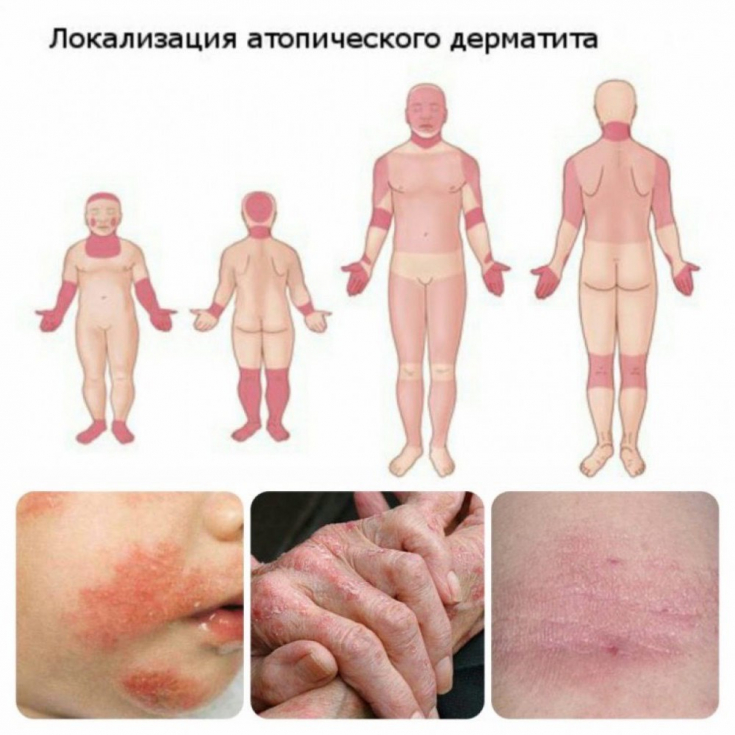Atopic dermatitis is a common chronic inflammatory skin disease in adults. Patients with atopic dermatitis have an increased risk of bacterial and viral skin infections, due in part to changes in the molecular composition of the skin barrier and an altered cell-mediated immune response. The use of systemic immunosuppressants can further reduce the patient's immune response. This article on estet-portal.com provides data confirming an increased risk of systemic skin infections in patients with atopic dermatitis.
- Interpretation of the results of a study on the association of atopic dermatitis and an increased risk of infectious processes
- Suggested mechanisms for the development of infectious processes in patients with atopic dermatitis
- Conclusion
Interpretation of the results of a study on the association of atopic dermatitis and an increased risk of infectious processes
The study involved 10,600 patients with atopic dermatitis and 106,000 adult controls. For every patient with atopic dermatitis, there were 10 people without an inpatient or outpatient diagnosis of atopic dermatitis.
All systemic infections that bring a person to hospital (hospitalizations, emergency room visits, or outpatient visits) identified by ICD-10 hospital discharge codes were investigated. Only primary diagnoses were analyzed. Systemic infections were classified based on the specific organ that was affected rather than the specific pathogen. However, two pathogens associated with atopic dermatitis have been separately studied, on this basis two categories have been defined: "staphylococcal infections"; and "herpetic infections".
See also: «Trigger" in the development of atopic dermatitis.
Infections of the lower respiratory tract and heart 58% and 4% among adults with atopic dermatitis compared with

33% and 2% among control adults, respectively. The highest population risk among the population with atopic dermatitis was associated with musculoskeletal infections and heart infections.
The results of the study strongly suggest an association between atopic dermatitis and potentially life-threatening infections, including endocarditis and sepsis. These data support the clinical relevance of reported cases of infective endocarditis associated with eczema flares. Two cross-sectional studies using the 2002-2012 national inpatient sample in the United States also found a higher prevalence of endocarditis and sepsis. A recent study based on Danish registries found that mortality from cardiovascular and infectious diseases was higher in adults with atopic dermatitis compared to healthy adults.
It is interesting to note that S.aureus bloodstream infections in patients with atopic dermatitis appear to be hospital acquired in about 60% of cases with skin infections and intravascular catheters as the main gateway of infection.
In addition, there is a higher risk of suspected hospital-acquired sepsis and "staph infections" among adults with atopic dermatitis, examining separately the primary and secondary diagnoses of infections given in the hospital system.
Read also: Research on approaches to the treatment of atopic dermatitis.
However, the observed increased risk of heart infections and sepsis should be interpreted with caution. Indeed, the absolute difference in the risk of heart infections is small, corresponding to 1.8 additional heart infections among adults with atopic dermatitis over a 20-year period.
The review and meta-analysis concluded that patients with atopic dermatitis are more likely to have infections affecting the ears, throat, and urinary tract. One additional study using a British GP medical record database also found an increased risk of otitis media, pneumonia and strep throat infection in patients with atopic dermatitis, but it only focused on the airways.
Suggested mechanisms for the development of infectious processes in patients with atopic dermatitis
Some pathophysiological mechanisms may explain the possible association between atopic dermatitis and increased susceptibility to systemic and skin infections. These mechanisms include elevated skin pH allowing staphylococci to colonize the skin, deficient activation and synthesis of antimicrobial peptides and filaggrin, which are known to reduce staphylococcal growth and skin microbiota diversity with increased S.aureus colonization.

Read also: Atopic Dermatitis Skin Care.
The association between atopic dermatitis and susceptibility loci associated with immune regulation, in particular innate host defense and T-cell function, is also considered.
Because AD patients with very active lesions have a high density of S.aureus, they may be at particular risk for sepsis and endocarditis.
This can be explained by superinfection of active lesions that become invasive, or through intravascular interventions.
Conclusion
This nationwide registry-based study found that adults diagnosed with atopic dermatitis in a hospital have an increased risk of developing systemic infections affecting the heart, musculoskeletal system, and respiratory tract, as well as sepsis and skin infections, compared with adults without diagnosis of atopic dermatitis. Clinicians should be aware of these potential associations when treating adults with atopic dermatitis.
Source: Journal of the American Academy of Dermatology.







Add a comment